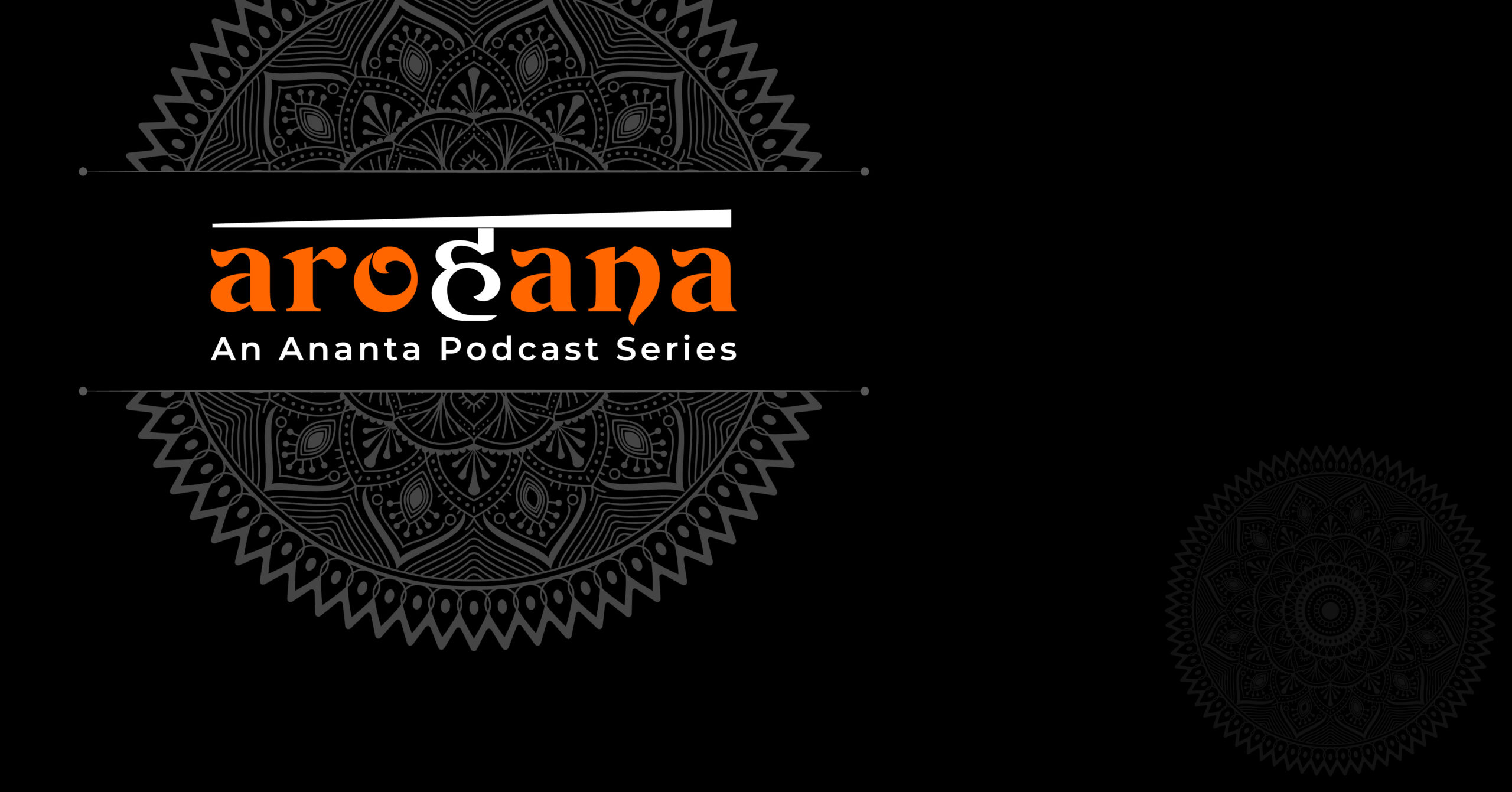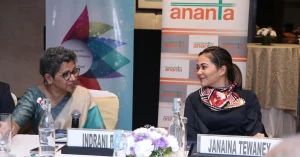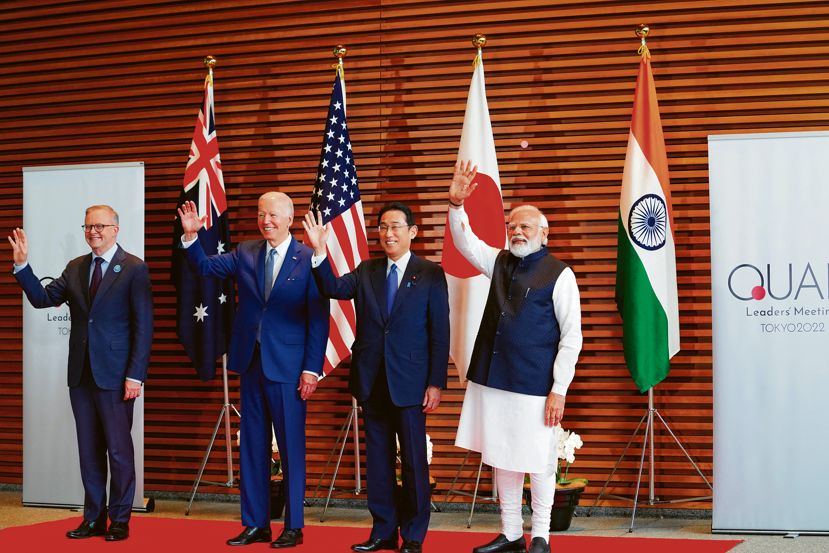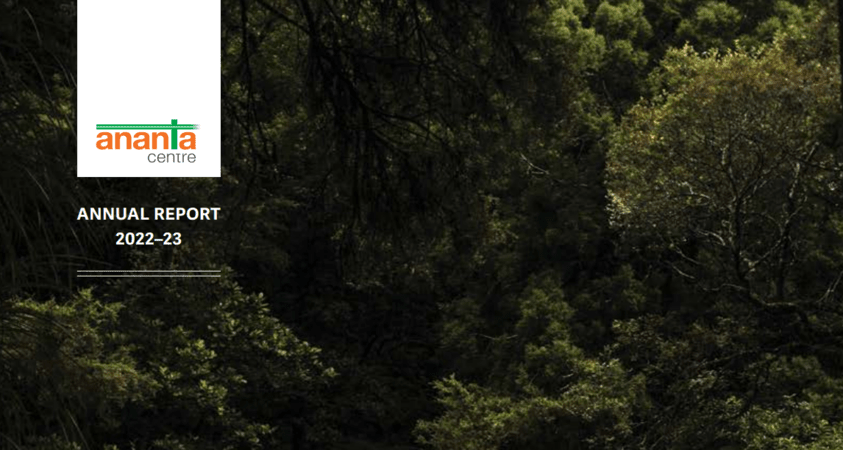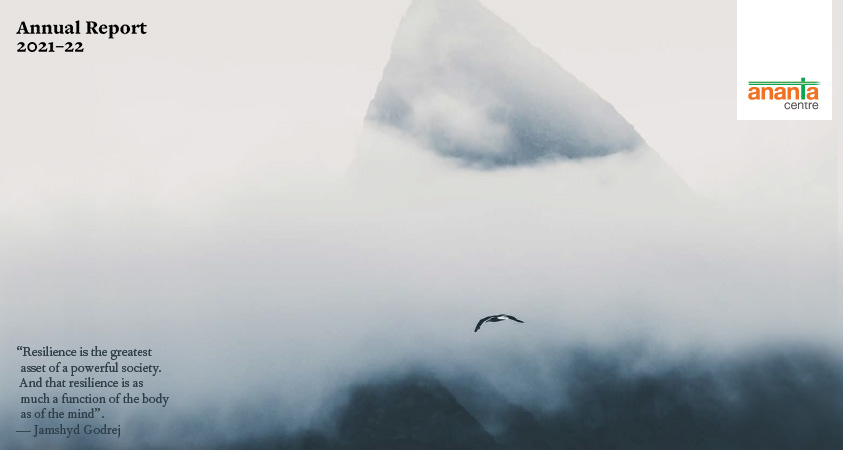HIGHLIGHTS
• Growth prospects take a hit after 2nd wave of COVID-19
• Finance Ministry plays down the overall impact on economy
• RBI rolls out package to address concerns over COVID-19
• Fillip to bond buying programme to help soften yields
• Loan restructuring move to help stressed MSMEs
• False cheer on industrial growth, real concern on inflation
• Automobile sales mask deeper industry-wide problems
• Good tidings on GST collections in April
• E-way bills generation shows worrying trend
• Manufacturing employment declines; farm jobs on the rise
• Labour participation in April falls for third month running
• Indians on a drug buying spree
Growth prospects take a hit after 2nd wave of Covid-19
As feared, the second wave of Covid-19 would have a measurable impact on India’s economic growth prospects for the current financial year of 2021-22. Earlier projections of double-digit growth, riding on an 8 per cent contraction in 2020-21, are being revisited. S&P Global Ratings has now scaled down India’s growth projections for the current year to 8.2 per cent, from its earlier forecast of 11 per cent. S&P Global Ratings has offered two scenarios for the economy. In a severe-impact scenario, the Indian economy may grow by only 8.2 per cent, while in a moderate-impact scenario, the growth would be expected to be around 9.8 per cent. Fitch Solutions, another rating agency, has put out its scaled down projections of growth at 9.5 per cent, while Credit Suisse is of the view that 2021-22 growth would be around 8.5-9 per cent. Care Ratings also forecast that growth in 2021-22 would be 9.2 per cent, with a downward bias, which could eventually widen the Centre’s fiscal deficit from the projected 6.8 per cent of GDP to 7.15 per cent in the current financial year. There are still some projections that place India’s growth rate in the current year at the double-digit level – Goldman Sachs at 11.1 per cent, Barclays at 11 per cent, Moody’s at 10.8 per cent, State Bank of India at 10.4 per cent and UBS at 10 per cent. Most importantly, the Reserve Bank of India (RBI) is still holding on to its earlier estimate of 10.5 per cent growth for the Indian economy. The next monetary policy review by the RBI in June will provide more clarity on the growth trajectory this year.
Finance ministry plays down overall impact on economy
The Union finance ministry conceded that the second wave of Covid-19 had created downside risks for the economy in the April-June quarter of 2021. But it played down its overall impact on the economy, particularly in comparison with the first wave of the pandemic last year. Such an assessment was driven by its hope that the vaccination programme would be rolled out faster in the coming months, which would bring down the disease transmission rate significantly, a hope that may be realised only in the latter half of the current year. The finance ministry’s note on Monthly Economic Review for April 2021 conceded that a few high-frequency indicators like e-way bills for GST and power consumption have seen “sequential moderation” in the second half of April. But the mixed economic trends, already evident, included a slight improvement in the Manufacturing Purchasing Manager’s Index at 55.5 in April, up from 55.4 in March, a decline in car sales in April, compared to the March numbers, a deceleration in the generation of e-way bills, muted growth in credit flows, buoyant agriculture in the hope of normal monsoon, which would soften inflationary pressure, and outflows of foreign portfolio investors to the tune of $1.18 billion in April.
RBI rolls out package to address concerns over Covid-19
The Reserve Bank of India (RBI) Governor, Shaktikanta Das, held an unscheduled media briefing on May 5 to unveil a package of measures, which was clearly the first concrete move at addressing the concerns arising out of the adverse impact of the second wave of Covid-19 on economic activities. The RBI package had important elements.
One, there was a Rs 50,000-crore package for vaccine makers, suppliers of medical equipment, hospitals and for patients, who may need funds to treat Covid-19. Banks could extend loans of this amount to the sectors identified till March 31, 2022. The loans thus given would be treated as part of the banks’ priority sector lending and will, therefore, enjoy all the accompanying benefits for a period of three years or till the repayments are made. The accompanying benefits of priority sector loans would mean that such lending would be exempted from the banks’ requirement of maintaining their cash-reserve ratio or statutory liquidity ratio with the RBI. This, along with the fact that the funds for this package can be obtained by banks at the current repo rate of 4 per cent, will help banks lend such loans at concessional rates. Banks would also be encouraged to park their surplus funds equivalent to the amount of Covid loans under this programme at a rate slightly higher (25 basis points) than the usual reverse repo rate of 3.35 per cent. More than the health-care providers, the vaccine makers would benefit from the package in a measurable way.
Small finance banks (SFB) also will be provided with funds to the tune of Rs 10,000 crore at the repo rate of 4 per cent, which they could lend to individuals, small and medium enterprises. SFBs will be incentivised to lend to micro-finance institutions as such loans, extended till March 2022, would be treated as priority sector lending till these are repaid.
Fillip to bond buying programme to help soften yields
RBI Governor Shaktikanta Das announced a programme for buying Rs 35,000 crore of bonds from the secondary market on May 20 as part of its Rs 1 lakh crore Government Securities Acquisition Programme (G-SAP) scheduled for the current quarter. Already, Rs 25,000 crore of bond buying was completed in April. The fresh announcement on bond buying under G-SAP had an immediate impact on the yield on the benchmark 10-year government bond, which fell below 6 per cent. A softening yield (or the interest rate) for bonds makes the RBI’s task of facilitating the bond auction programme it conducts on behalf of the Union government, which is set to go in for a significant amount of borrowing to meet its expenditure in the current financial year.
Loan restructuring move to help stressed MSMEs
Yet another move of the RBI pertained to the micro, small and medium enterprises (MSMEs). Recognising that small entrepreneurs, small and medium enterprises have already been hit hard by the second wave of Covid-19, Governor Das announced the Resolution Framework 2.0 for such units allowing retail borrowers and small business to recast their loans without being downgraded to the non-performing category. This was somewhat similar to the scheme announced during the first wave of Covid-19 last year. The key features of the second resolution scheme are: The one-time restructuring scheme is to be available to borrowers with standard accounts as of March 31, 2021 and with an exposure of up to Rs 25 crore; Borrowers who had received the benefits in the first scheme would not be able to take advantage of the new scheme; and all MSMEs, which are not exempted from the requirement of GST registration would be eligible provided they are registered with the GST system. Although the banking sector’s exposure to MSMEs is estimated at over Rs 13 lakh crore, the new scheme is expected to be of greater benefit to small borrowers. But with the package already announced by the RBI in May, it remains to be seen how the Monetary Policy Committee responds to the challenges of the second wave of Covid-19 as it reviews the situation in the first week of June. Equally interesting would be the response of the Union government to the emerging crisis.
False cheer on industrial growth, real concern on inflation
There was some cheer when the National Statistical Office announced in May that industrial growth for March 2021 was estimated at 22.4 per cent after two consecutive months of contraction. But a closer look at the number revealed that the sharp increase was due to the low-base effect. In March 2020, industrial output had contracted by over 18 per cent, thanks to the advent of an economic slowdown and the start of the economic lockdown. Compared to the Index of Industrial Production (IIP) for March 2019, the March 2021 performance on the industrial output front represented a contraction of 0.5 per cent. Not surprisingly, the full financial year of 2020-21 ended with an industrial output contraction of 8.6 per cent, over and above a 0.8 per cent contraction in the full financial year of 2019-20. Since manufacturing accounts for almost 75 per cent of the IIP, a continued contraction in industrial output for two years in succession does not augur well for the economy.
Inflation, however, provided a mixed picture. Retail inflation, based on the movement in the Consumer Price Index (CPI), eased to a three-month low of 4.29 per cent in April. But for the same month, inflation measured on the basis of the Wholesale Price Index (WPI) shot up to an 11-year high of 10.49 per cent. CPI-based inflation declined from 5.52 per cent in March 2021 and 7.72 per cent in April 2020. But economists feared that retail inflation could see a northward movement in the coming months. With WPI-based inflation already in double digits, triggered by a rise in fuel and commodity prices, there are fears of a build-up of inflationary pressures, since such a trend would affect input costs for producers. A bigger worry is whether the projections on both retail and wholesale inflation would make members of the Monetary Policy Committee of the Reserve Bank of India (RBI) change their stance or force a rethink on their approach to interest rates.
Automobile sales mask deeper industry-wide problems
How did retail sales of automobiles do in April 2021? Comparing them with the sales in April 2020 will provide no meaningful indication because there were no sales in that month because of the economic lockdown. A more reasonable comparison would be to measure the April 2021 retail sales with those in April 2019. Such a comparison brings out the sombre fact that retail sales of all automobile sales in April 2021 at 1.18 million units were 32 per cent lower than 1.74 million units recorded in April 2019. Of all the segments, tractors made the smartest recovery at 3.5 per cent (with sales of over 38,200 units in April 2021, compared with about 37,000 units two years ago), but passenger vehicle sales fell by about 12 per cent to 0.2 million in this period. The sharpest fall – about 55 per cent – was in the sales of three-wheelers (just about 21,600 units), while two-wheelers and commercial vehicles also performed poorly at a sales decline of 35 per cent (at 0.86 million units) and 34 per cent (at 51,400 units), respectively. If you want to gauge the actual level of stress in the auto industry’s sales performance, look out for data on retail sales and not just the wholesale despatches by automobile companies to their dealers. The latter often masks the actual level of demand and offtake in the retail market. If you want to look at the despatches to dealers, a better way would be to look at the month-on-month factory despatches of vehicles to the dealers in April 2021. Such data compiled by Care Ratings show a decline of 33.5 per cent for two-wheelers, 57 per cent for three-wheelers, 10 per cent for passenger vehicles, 57 per cent for medium and heavy commercial vehicles and 58 per cent for light commercial vehicles. The stress even by this yardstick is no less worrying.
Good tidings on GST collections in April
The news on the Goods and Services Tax (GST) front in May initially brought cheer for everyone. The GST collections reported during April rose to an all-time high of Rs 1.41 lakh crore. This meant GST collections stayed well above the Rs 1 lakh crore mark for the seventh consecutive month. The April collection was 14 per cent higher than what was recorded in March 2021. And when compared with the same month of 2020, the increase in April 2021 was over three times. But this huge increase was because of the low base effect; remember that the April 2020 collections reflected the impact of the economic lockdown enforced last year in the wake of the first wave of Covid-19. But how robust was the April 2021 GST collection could be gauged from the increase they recorded over the figures of April 2019 and April 2018 at 24 per cent and 37 per cent, respectively. Necessary caveats must, however, be introduced to evaluate the real import of these numbers. Under GST, the collections for a month are from transactions conducted a month earlier. The April 2021 collections, therefore, reflect the transactions in March 2021, which is the last month of the financial year and, therefore, does usually see a year-end bump. In spite of that, however, the increase is significant. According to government officials, the increase, among other things, was due to improved anti-evasion measures and the use of technology to track transactions that would earlier go untaxed. The increase, therefore, is also due to significantly improved compliance.
E-way bills generation shows worrying trend
The big question is how long this increase will remain sustainable. The second wave of Covid-19 began having an adverse impact on transactions in April. The GST to be paid for transactions made in April would be captured in the collections during May. Already, there are reports that e-way bill generation for GST-related transactions has seen a drop in April. Total e-way bills generation in the first month of 2021-22 were estimated at 58.7 million or about 1.95 million bills generated per day on average, compared to a total of 71.2 million e-way bills in March or a daily average of 2.29 million e-way bills in March. The April e-way bills volume is the lowest since November 2020. E-way bills are now compulsorily required before consignments, valued at over Rs 50,000, could be moved from one place to another. Hence, e-way bills provide an early indication of the GST collection trends. Experts worry that, with the dip in e-way bills generation in April, GST collections for May 2021 will certainly decline. Will they fall below Rs 1 lakh crore, as experts fear? Only time will tell. Early indications for e-way bills in the first half of May show that they have remained depressed at about 1.21 million, the lowest since May 2020, when it had fallen to 0.87 million per day. GST collections in May, to be reflected in the number for June may not bring cheer to the government.
Manufacturing employment declines; farm jobs on the rise
A study conducted by the Centre for Economic Data and Analysis (CEDA) of Ashoka University and the Centre for Monitoring the Indian Economy (CMIE) has brought out disturbing trends on the employment front. The study analyses data from 2016-17 (the year of demonetisation) to 2020-21 (the year of Covid-19) and provides a fresh perspective on employment in seven sectors (agriculture, mining, manufacturing, real estate and construction, financial services, non-financial services and public administration services), which account for almost 99 per cent of total employment in the country. The most worrying conclusion of the study is that the manufacturing sector, which accounts for about 17 per cent of gross domestic product, saw its employment level drop from 51 million in 2016-17 to 27.3 million in 2020-21. However, the 46 per cent decline in employment in the manufacturing sector during this period is not the whole story. Of the four years in question, the employment in the manufacturing sector fell only in two years – in 2016-17 and 2020-21. The employment level in the remaining two years of 2017-18 and 2018-19 remained unchanged. In other words, the employment in the manufacturing sector bore the brunt of demonetisation and Covid-19. Employment in the real estate and construction sector saw a consistent fall in all the four years under study – from 69 million to 54 million. Mining employment also fell significantly from 1.44 million in 2016-17 to 0.88 million. In the services sector, employment fell in financial services and public administrative services, but showed a small rise in non-financial services. The big change was in agriculture, which presumably absorbed a part of the employment that was lost in the manufacturing, real estate and construction sectors. Interestingly, agriculture saw its employment level in 2017-18 and 2018-19 drop from 145.6 million recorded in 2015-16. But after 2018-19, farm employment began rising – to 145.9 million in 2019-20 and to 151.8 million in 2020-21. Clearly, the last four years saw a significant shift in the composition of employment in the Indian economy, if the CEDA-CMIE analysis is any indication. While the loss of employment in manufacturing was steep, only a small part of it could be absorbed in agriculture whose employment numbers rose. In other words, the share of agriculture in employment rose from 69 per cent in 2016-17 to 78 per cent in 2020-21, the share of manufacturing, mining, real estate and construction in employment in the same period fell from 30 per cent to 21 per cent.
Labour participation in April falls for third month running
The employment situation in April got worse, not just because of a rise in the unemployment rate, but more worryingly as a result of a fall in the labour force participation rate or LFPR. According to the employment data collected by the CMIE, LFPR fell in April 2021 for the third month running to around 40 per cent. LFPR, which is an indicator of the number of people who are in the job market either working or looking for a job, had fallen in February and dropped sharply in March and now again in April, bringing down India’s estimated labour force to a number of 425 million. Even in a reduced labour force market, the unemployment rate spurted from 6.5 per cent in March to 8 per cent in April, thanks largely due to lockdowns enforced in many states in the wake of the second wave of Covid-19. According to the CMIE, prospects of a sharp recovery in the job situation in the remaining months of 2021-22 look dim as growth will be adversely impacted and fresh investments would be scarcer as the capacity utilisation in industry has dipped to 66.6 per cent. That the employment situation in rural India got worse was an additional cause for concern. Rural joblessness, according to the CMIE, doubled to over 14 per cent for the week ended May 16, compared to 7.29 per cent in the previous week.
Indians on a drugs buying spree
The growth in the sales of medicines in April scaled a new high. The total sales of domestic pharmaceutical products in April 2021 were estimated at Rs 15,662 crore – up 51 per cent, compared to Rs 10,337 crore in the same month of 2020. If you thought that the April 2020 sales were low because of the lockdown, the comparison with the April 2019 sales shows that the growth this year was 37 per cent. Even when compared with March 2021, the medicine sales in April 2021 represented an increase of 18 per cent. Apart from the low-base effect, two other factors were behind the 51 per cent bump in sales in April 2021 – steady demand growth for all kinds of medicines and an increase in the purchase of Covid-19 drugs in the wake of the second wave of the pandemic. Segment-wise sales of medicines reveal an interesting trend. The largest increase – of 134 per cent – has been noticed in anti-infectives, followed by a 76 per cent rise in nutritional medicines. The generally buoyant stock prices of drug companies like Cipla, Glenmark, Zydus Cadila and Dr Reddy’s are an indication of the sharp growth in their top line, which presumably would also result in a similar increase in their bottom line.
Supported by
………………………………………………………………………………………………
(The views expressed are personal)
………………………………………………………………………………………………




